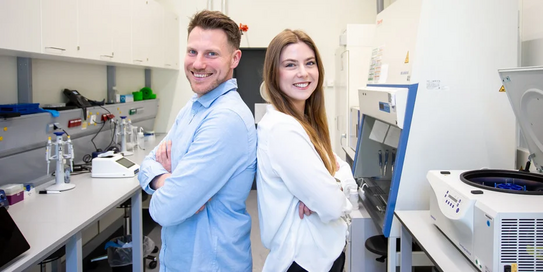"The biggest advantage of electronic lab notebooks is that everything is bundled in one place"

Dr. Alexander Schenk is laboratory head of the sports medicine laboratory at the Institute of Sport and Sport Science. Together with scientific associate Julia Dreilich, he reports on the implementation of the electronic lab notebook eLabFTW. In this interview, they explain the advantages for laboratory organization and the extent to which its use facilitates the work processes for management, staff and students.
How did the introduction of an electronic lab book come about?
Alexander Schenk: Before we moved into the new sports extension building, I was accomodated externally in the laboratory of the Leibniz Research Centre for Working Environment and Human Factors at TU Dortmund University (IfADo), where eLabFTW was introduced in 2023. That's where I first came into contact with it, recognized the advantages and presented it to my group with the question of whether we wanted to start directly digitally in the new laboratory of the Sports Medicine department instead of using paper notebooks. The idea was well received, so I contacted the ITMC and the research data service. The electronic notebooks Sciformation and eLabFTW were available for selection. As Sciformation was developed specifically for chemistry, eLabFTW was recommended to us. It was no problem at all to set up a virtual machine (VM) and install eLabFTW on it. Overall, everything went very quickly: the eLabFTW was up and running and ready for use in less than three months. Students who work with us in the lab, for example in internships or for final theses, are also given access so that they can use the electronic lab book for organization and documentation.
What are the advantages of using an electronic lab notebook?
Julia Dreilich: The biggest advantage is that there is no more paperwork and everything is stored centrally in one place and remains accessible - even from multiple locations. This applies not only to the data contents, but also to documents, protocols or reagents that have been stored. This means you don't have to ask the lab manager in person if you are looking for something - everything is immediately available digitally. Experiments can have various statuses - such as “in implementation”, “successful”, ‘unsuccessful’ or “ongoing” - so that everyone knows the current state. Entries are time-stamped, making it easy to track processes. The system makes it possible to work on experiments in groups, but to restrict access to those actually involved. My favorite feature is the integrated calendar, in which all devices and lab stations are stored. It makes scheduling and lab organization much easier, as you can see directly who has booked what. It is also more data protection-friendly than a Google calendar, for example.
Schenk: The biggest advantage is that everything is bundled in one place. As soon as I invest the work once and set up an experiment, anyone can work with it afterwards. Experiments can be linked to resources such as protocols, standard operating procedures (SOPs), materials and chemicals - including stored safety data sheets. This makes preparation easier, especially for students, and increases safety in the lab. This means that everyone has immediate access to the necessary information without having to search through folders. The system is also clearly organized according to tests, experiments and studies. In contrast to the paper-based lab book, which is kept chronologically and requires time-consuming searching, I can access my records much more easily here. Instead of paper books, which I would have to keep forever, regular backups of the eLabFTW are created and stored securely.
Dreilich: Especially when you start working in the lab or implementing new experiments, you can directly see what others have already done and what has worked out. This allows you to make decisions without having to try everything out yourself or constantly consult others. When a new project or experiment is started, the person responsible registers in eLabFTW and enters all the relevant information. This is the case for all our studies and works perfectly.
What would you like to optimize in the future when using the electronic lab notebook?
Dreilich: My only wish is to be able to use the eLabFTW directly in the lab. At the moment, entries are still made on the computer at the desk, but I know that a laboratory tablet is already planned so that I can access and work directly on site in future.
Schenk: A more standardized structure could be helpful to make it easier to follow other people's notes, even though I appreciate the individuality. So far it's working well and I occasionally look at other people's SOPs to check that I understand their approaches. I think we are already using the system very well and I am very happy with it.
About the people:
- Dr. Alexander Schenk has been laboratory head at the Institute of Sport and Sport Science at TU Dortmund University since 2020 and completed his doctorate at the German Sport University Cologne
- Julia Dreilich is a research associate and doctoral candidate at the Institute of Sport and Sports Science
Further information:
About research data management at TU Dortmund University
Dr. Alexander Schenk and Julia Dreilich are portrayed as Data Champions because they have created a digitally supported laboratory environment through the introduction of the electronic labbook eLabFTW, from which laboratory management, staff and students benefit equally.

